HI6025 Accounting Theory: Employee Benefits Role in Accounting
VerifiedAdded on 2023/06/03
|11
|2365
|233
Report
AI Summary
This report examines the role of employee benefits in contemporary accounting practices, drawing upon two articles from "The Accounting Review" and "Australian Accounting Review: Melbourne." It investigates how employee benefits influence internal control weaknesses, financial restatements, and independent audit limitations. The report highlights that employee-friendly policies motivate employees, reduce errors, and improve the reliability of audit reports. It further discusses the implications of these findings for accountants, accounting regulators, and investors in Australian companies, emphasizing the importance of employee motivation in protecting organizational resources and attracting investments. Access more solved assignments and resources on Desklib.
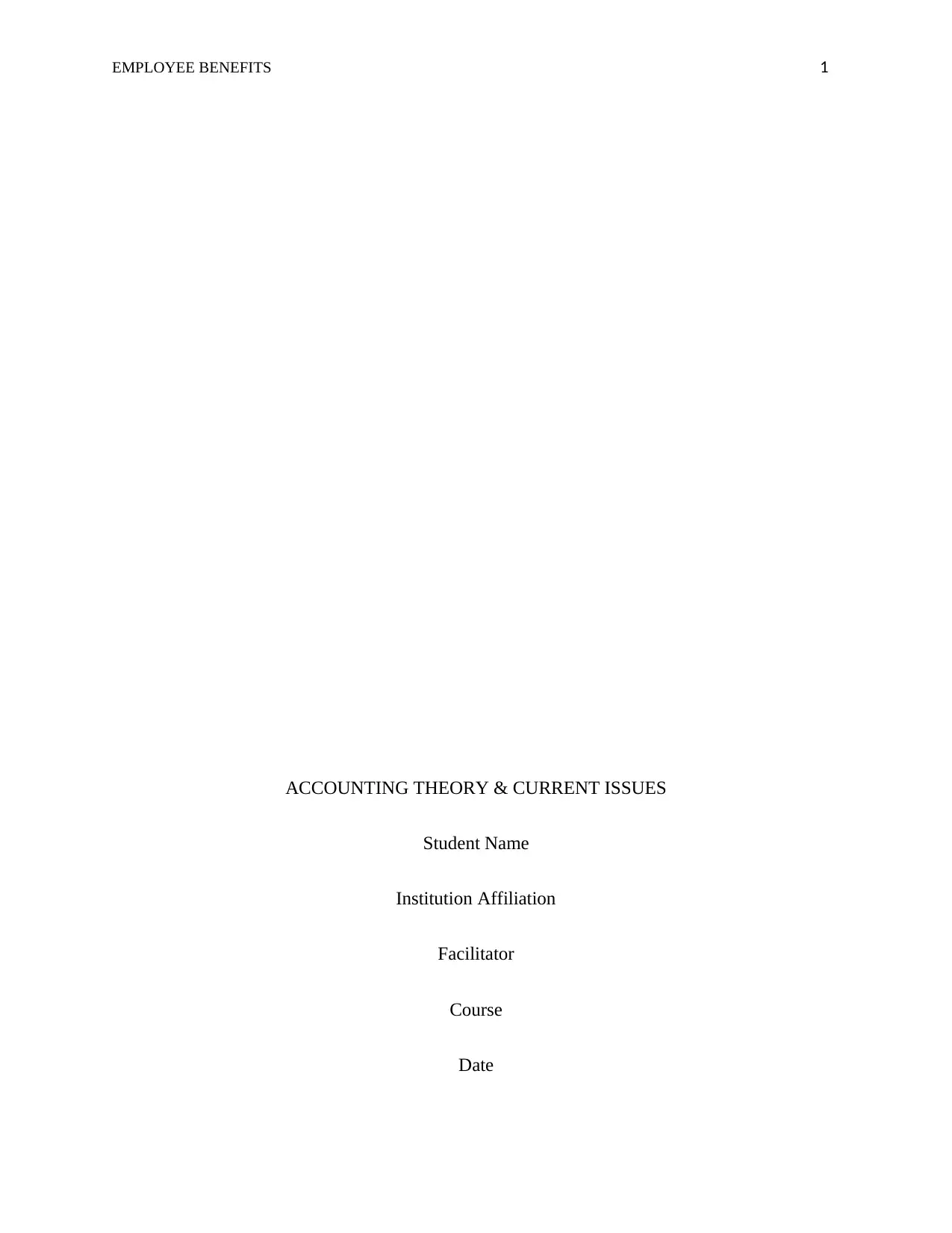
EMPLOYEE BENEFITS 1
ACCOUNTING THEORY & CURRENT ISSUES
Student Name
Institution Affiliation
Facilitator
Course
Date
ACCOUNTING THEORY & CURRENT ISSUES
Student Name
Institution Affiliation
Facilitator
Course
Date
Paraphrase This Document
Need a fresh take? Get an instant paraphrase of this document with our AI Paraphraser
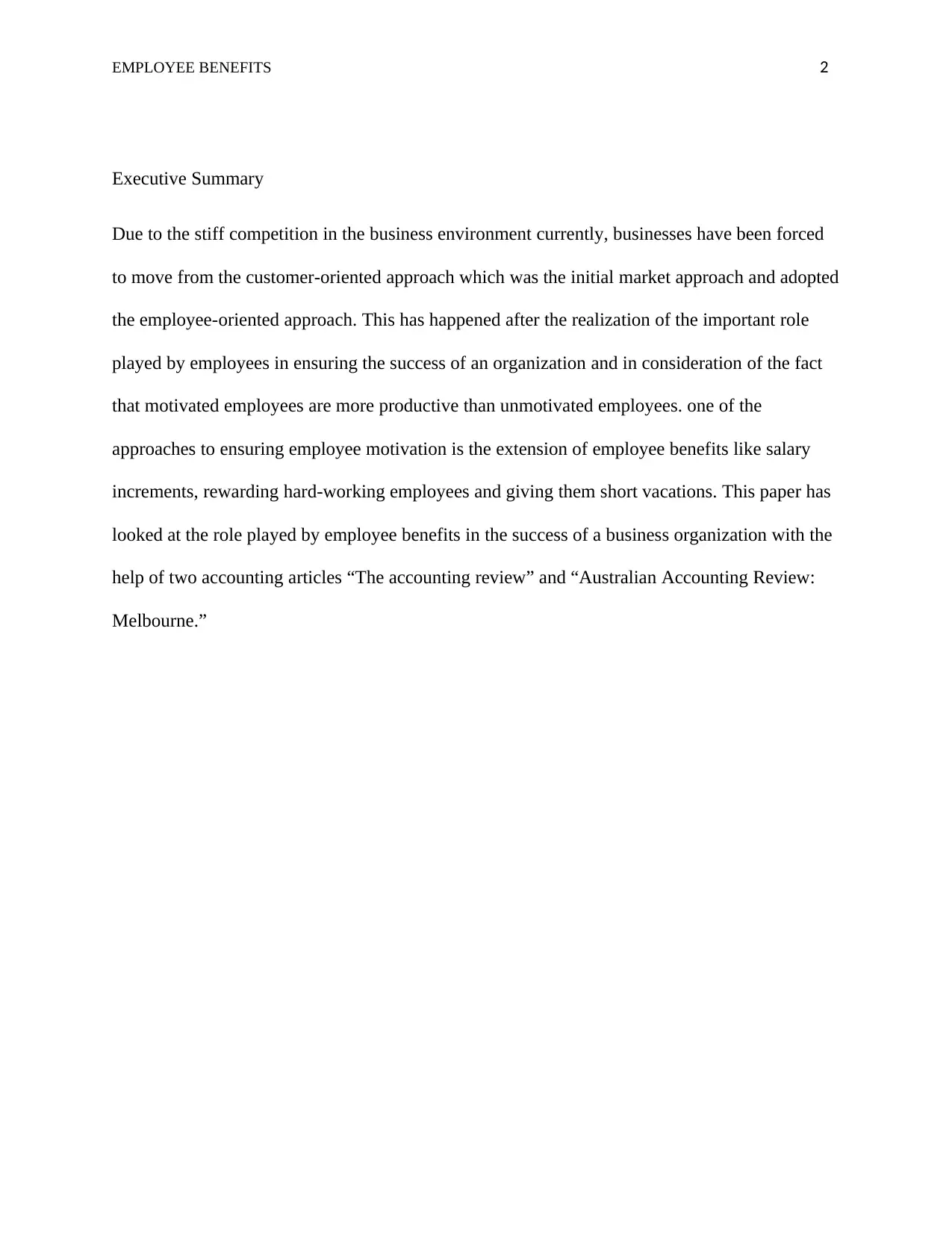
EMPLOYEE BENEFITS 2
Executive Summary
Due to the stiff competition in the business environment currently, businesses have been forced
to move from the customer-oriented approach which was the initial market approach and adopted
the employee-oriented approach. This has happened after the realization of the important role
played by employees in ensuring the success of an organization and in consideration of the fact
that motivated employees are more productive than unmotivated employees. one of the
approaches to ensuring employee motivation is the extension of employee benefits like salary
increments, rewarding hard-working employees and giving them short vacations. This paper has
looked at the role played by employee benefits in the success of a business organization with the
help of two accounting articles “The accounting review” and “Australian Accounting Review:
Melbourne.”
Executive Summary
Due to the stiff competition in the business environment currently, businesses have been forced
to move from the customer-oriented approach which was the initial market approach and adopted
the employee-oriented approach. This has happened after the realization of the important role
played by employees in ensuring the success of an organization and in consideration of the fact
that motivated employees are more productive than unmotivated employees. one of the
approaches to ensuring employee motivation is the extension of employee benefits like salary
increments, rewarding hard-working employees and giving them short vacations. This paper has
looked at the role played by employee benefits in the success of a business organization with the
help of two accounting articles “The accounting review” and “Australian Accounting Review:
Melbourne.”
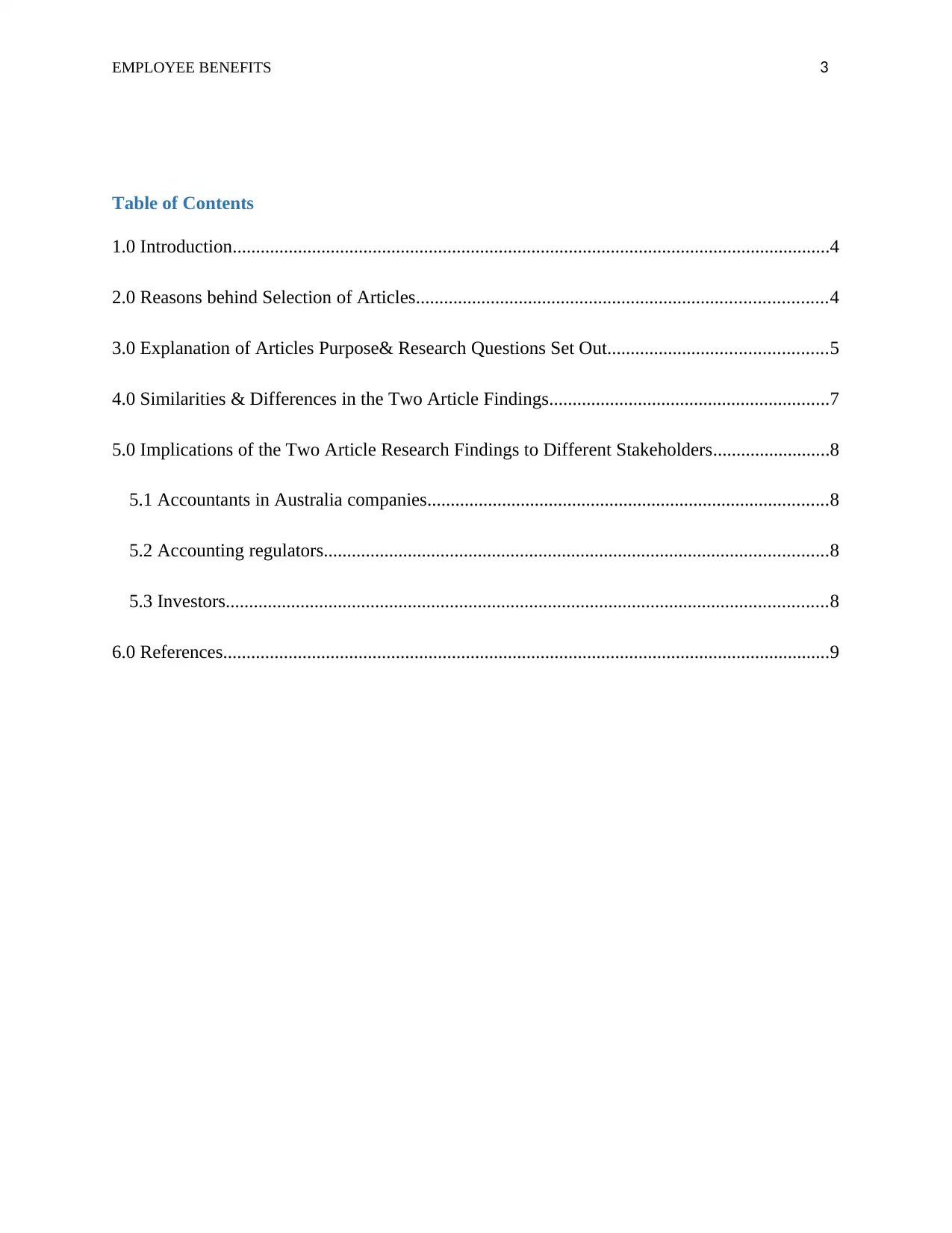
EMPLOYEE BENEFITS 3
Table of Contents
1.0 Introduction................................................................................................................................4
2.0 Reasons behind Selection of Articles........................................................................................4
3.0 Explanation of Articles Purpose& Research Questions Set Out...............................................5
4.0 Similarities & Differences in the Two Article Findings............................................................7
5.0 Implications of the Two Article Research Findings to Different Stakeholders.........................8
5.1 Accountants in Australia companies......................................................................................8
5.2 Accounting regulators............................................................................................................8
5.3 Investors.................................................................................................................................8
6.0 References..................................................................................................................................9
Table of Contents
1.0 Introduction................................................................................................................................4
2.0 Reasons behind Selection of Articles........................................................................................4
3.0 Explanation of Articles Purpose& Research Questions Set Out...............................................5
4.0 Similarities & Differences in the Two Article Findings............................................................7
5.0 Implications of the Two Article Research Findings to Different Stakeholders.........................8
5.1 Accountants in Australia companies......................................................................................8
5.2 Accounting regulators............................................................................................................8
5.3 Investors.................................................................................................................................8
6.0 References..................................................................................................................................9
⊘ This is a preview!⊘
Do you want full access?
Subscribe today to unlock all pages.

Trusted by 1+ million students worldwide
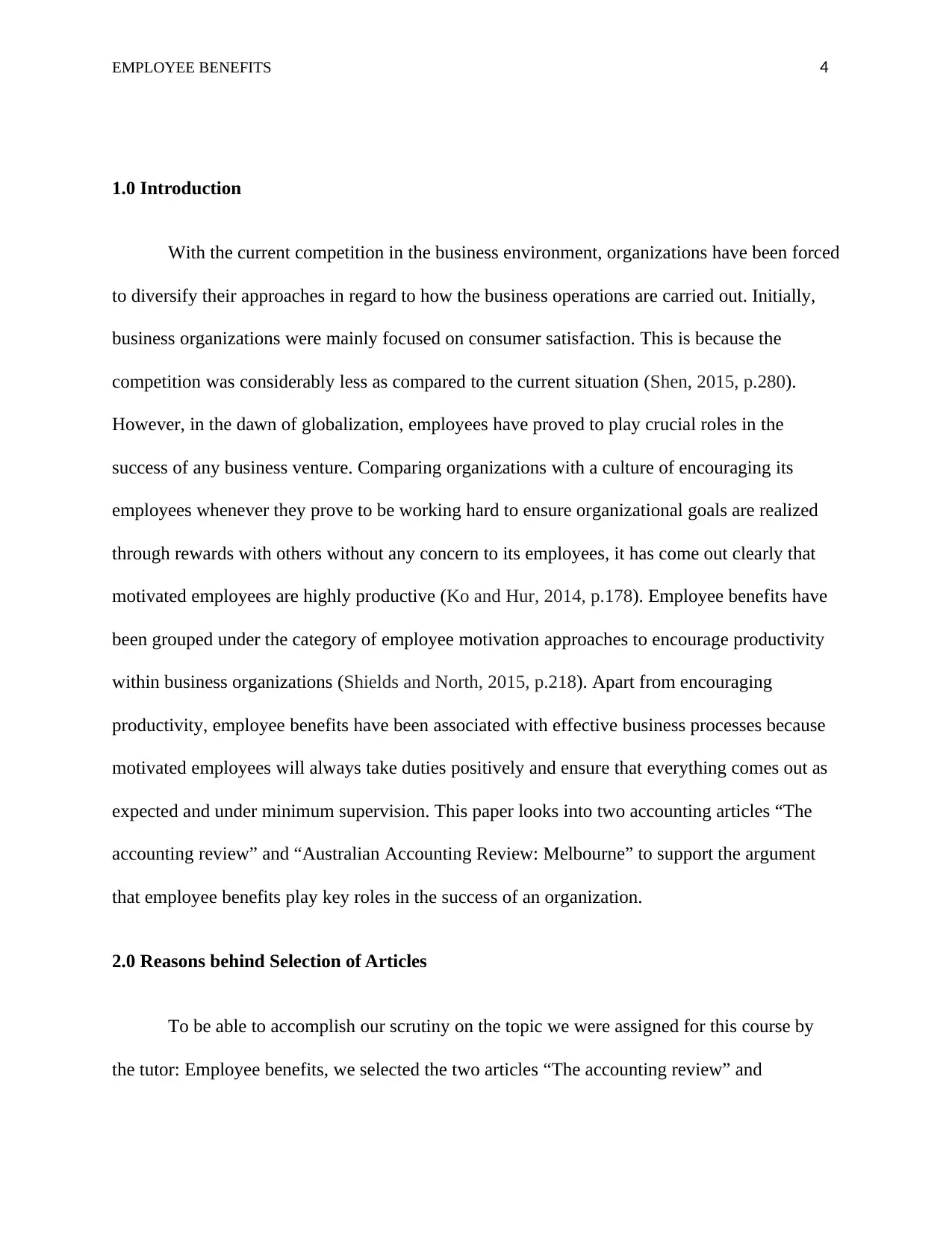
EMPLOYEE BENEFITS 4
1.0 Introduction
With the current competition in the business environment, organizations have been forced
to diversify their approaches in regard to how the business operations are carried out. Initially,
business organizations were mainly focused on consumer satisfaction. This is because the
competition was considerably less as compared to the current situation (Shen, 2015, p.280).
However, in the dawn of globalization, employees have proved to play crucial roles in the
success of any business venture. Comparing organizations with a culture of encouraging its
employees whenever they prove to be working hard to ensure organizational goals are realized
through rewards with others without any concern to its employees, it has come out clearly that
motivated employees are highly productive (Ko and Hur, 2014, p.178). Employee benefits have
been grouped under the category of employee motivation approaches to encourage productivity
within business organizations (Shields and North, 2015, p.218). Apart from encouraging
productivity, employee benefits have been associated with effective business processes because
motivated employees will always take duties positively and ensure that everything comes out as
expected and under minimum supervision. This paper looks into two accounting articles “The
accounting review” and “Australian Accounting Review: Melbourne” to support the argument
that employee benefits play key roles in the success of an organization.
2.0 Reasons behind Selection of Articles
To be able to accomplish our scrutiny on the topic we were assigned for this course by
the tutor: Employee benefits, we selected the two articles “The accounting review” and
1.0 Introduction
With the current competition in the business environment, organizations have been forced
to diversify their approaches in regard to how the business operations are carried out. Initially,
business organizations were mainly focused on consumer satisfaction. This is because the
competition was considerably less as compared to the current situation (Shen, 2015, p.280).
However, in the dawn of globalization, employees have proved to play crucial roles in the
success of any business venture. Comparing organizations with a culture of encouraging its
employees whenever they prove to be working hard to ensure organizational goals are realized
through rewards with others without any concern to its employees, it has come out clearly that
motivated employees are highly productive (Ko and Hur, 2014, p.178). Employee benefits have
been grouped under the category of employee motivation approaches to encourage productivity
within business organizations (Shields and North, 2015, p.218). Apart from encouraging
productivity, employee benefits have been associated with effective business processes because
motivated employees will always take duties positively and ensure that everything comes out as
expected and under minimum supervision. This paper looks into two accounting articles “The
accounting review” and “Australian Accounting Review: Melbourne” to support the argument
that employee benefits play key roles in the success of an organization.
2.0 Reasons behind Selection of Articles
To be able to accomplish our scrutiny on the topic we were assigned for this course by
the tutor: Employee benefits, we selected the two articles “The accounting review” and
Paraphrase This Document
Need a fresh take? Get an instant paraphrase of this document with our AI Paraphraser
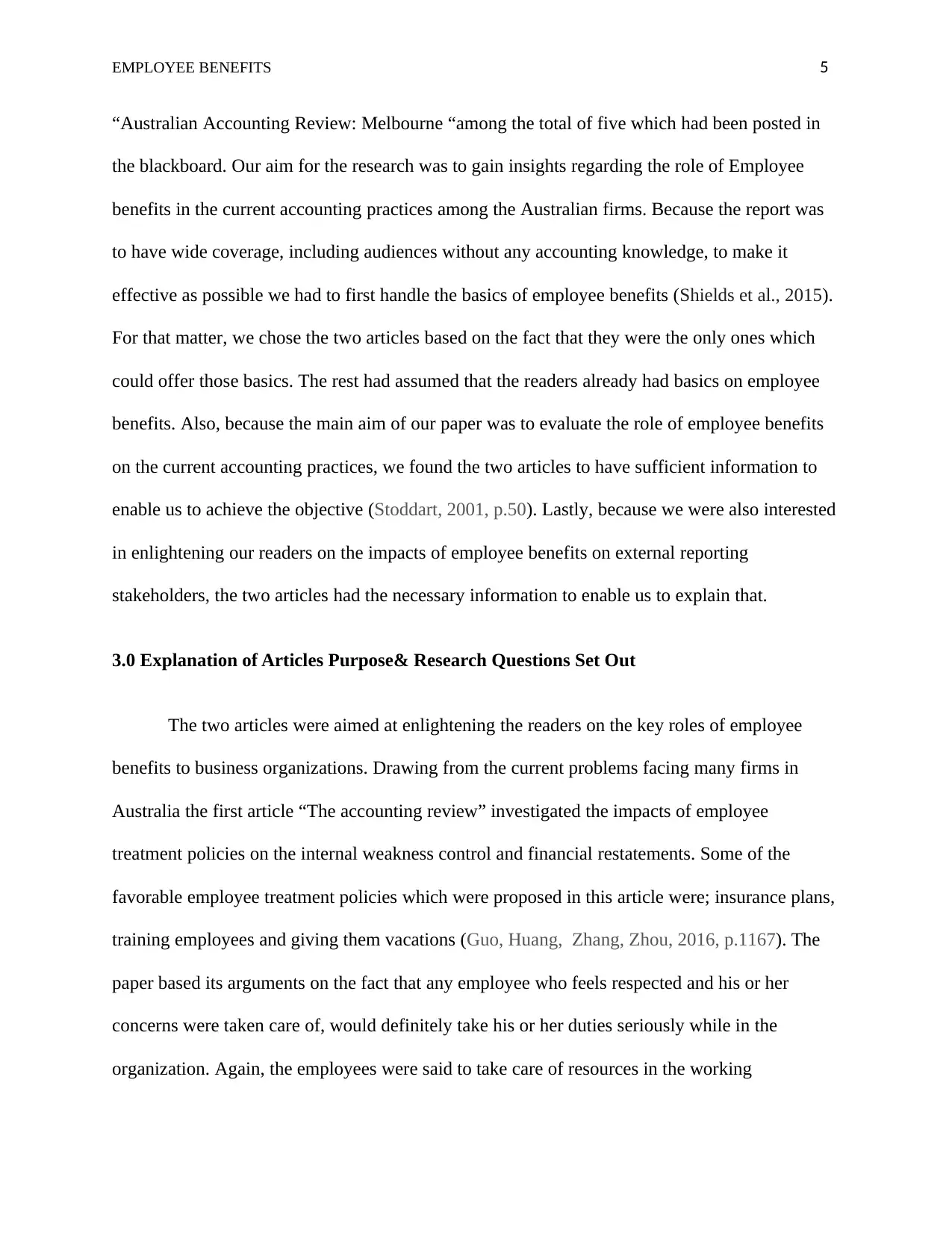
EMPLOYEE BENEFITS 5
“Australian Accounting Review: Melbourne “among the total of five which had been posted in
the blackboard. Our aim for the research was to gain insights regarding the role of Employee
benefits in the current accounting practices among the Australian firms. Because the report was
to have wide coverage, including audiences without any accounting knowledge, to make it
effective as possible we had to first handle the basics of employee benefits (Shields et al., 2015).
For that matter, we chose the two articles based on the fact that they were the only ones which
could offer those basics. The rest had assumed that the readers already had basics on employee
benefits. Also, because the main aim of our paper was to evaluate the role of employee benefits
on the current accounting practices, we found the two articles to have sufficient information to
enable us to achieve the objective (Stoddart, 2001, p.50). Lastly, because we were also interested
in enlightening our readers on the impacts of employee benefits on external reporting
stakeholders, the two articles had the necessary information to enable us to explain that.
3.0 Explanation of Articles Purpose& Research Questions Set Out
The two articles were aimed at enlightening the readers on the key roles of employee
benefits to business organizations. Drawing from the current problems facing many firms in
Australia the first article “The accounting review” investigated the impacts of employee
treatment policies on the internal weakness control and financial restatements. Some of the
favorable employee treatment policies which were proposed in this article were; insurance plans,
training employees and giving them vacations (Guo, Huang, Zhang, Zhou, 2016, p.1167). The
paper based its arguments on the fact that any employee who feels respected and his or her
concerns were taken care of, would definitely take his or her duties seriously while in the
organization. Again, the employees were said to take care of resources in the working
“Australian Accounting Review: Melbourne “among the total of five which had been posted in
the blackboard. Our aim for the research was to gain insights regarding the role of Employee
benefits in the current accounting practices among the Australian firms. Because the report was
to have wide coverage, including audiences without any accounting knowledge, to make it
effective as possible we had to first handle the basics of employee benefits (Shields et al., 2015).
For that matter, we chose the two articles based on the fact that they were the only ones which
could offer those basics. The rest had assumed that the readers already had basics on employee
benefits. Also, because the main aim of our paper was to evaluate the role of employee benefits
on the current accounting practices, we found the two articles to have sufficient information to
enable us to achieve the objective (Stoddart, 2001, p.50). Lastly, because we were also interested
in enlightening our readers on the impacts of employee benefits on external reporting
stakeholders, the two articles had the necessary information to enable us to explain that.
3.0 Explanation of Articles Purpose& Research Questions Set Out
The two articles were aimed at enlightening the readers on the key roles of employee
benefits to business organizations. Drawing from the current problems facing many firms in
Australia the first article “The accounting review” investigated the impacts of employee
treatment policies on the internal weakness control and financial restatements. Some of the
favorable employee treatment policies which were proposed in this article were; insurance plans,
training employees and giving them vacations (Guo, Huang, Zhang, Zhou, 2016, p.1167). The
paper based its arguments on the fact that any employee who feels respected and his or her
concerns were taken care of, would definitely take his or her duties seriously while in the
organization. Again, the employees were said to take care of resources in the working
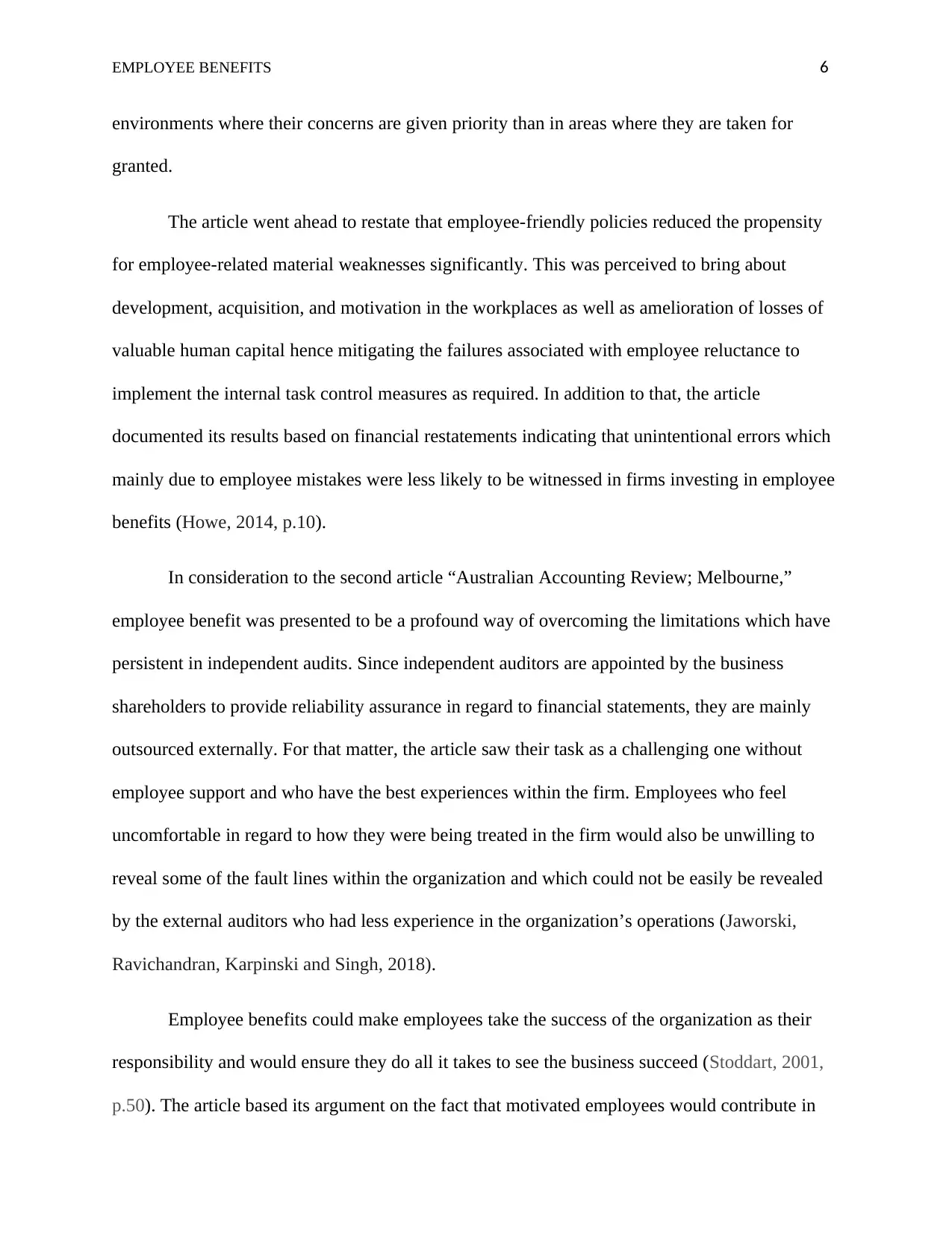
EMPLOYEE BENEFITS 6
environments where their concerns are given priority than in areas where they are taken for
granted.
The article went ahead to restate that employee-friendly policies reduced the propensity
for employee-related material weaknesses significantly. This was perceived to bring about
development, acquisition, and motivation in the workplaces as well as amelioration of losses of
valuable human capital hence mitigating the failures associated with employee reluctance to
implement the internal task control measures as required. In addition to that, the article
documented its results based on financial restatements indicating that unintentional errors which
mainly due to employee mistakes were less likely to be witnessed in firms investing in employee
benefits (Howe, 2014, p.10).
In consideration to the second article “Australian Accounting Review; Melbourne,”
employee benefit was presented to be a profound way of overcoming the limitations which have
persistent in independent audits. Since independent auditors are appointed by the business
shareholders to provide reliability assurance in regard to financial statements, they are mainly
outsourced externally. For that matter, the article saw their task as a challenging one without
employee support and who have the best experiences within the firm. Employees who feel
uncomfortable in regard to how they were being treated in the firm would also be unwilling to
reveal some of the fault lines within the organization and which could not be easily be revealed
by the external auditors who had less experience in the organization’s operations (Jaworski,
Ravichandran, Karpinski and Singh, 2018).
Employee benefits could make employees take the success of the organization as their
responsibility and would ensure they do all it takes to see the business succeed (Stoddart, 2001,
p.50). The article based its argument on the fact that motivated employees would contribute in
environments where their concerns are given priority than in areas where they are taken for
granted.
The article went ahead to restate that employee-friendly policies reduced the propensity
for employee-related material weaknesses significantly. This was perceived to bring about
development, acquisition, and motivation in the workplaces as well as amelioration of losses of
valuable human capital hence mitigating the failures associated with employee reluctance to
implement the internal task control measures as required. In addition to that, the article
documented its results based on financial restatements indicating that unintentional errors which
mainly due to employee mistakes were less likely to be witnessed in firms investing in employee
benefits (Howe, 2014, p.10).
In consideration to the second article “Australian Accounting Review; Melbourne,”
employee benefit was presented to be a profound way of overcoming the limitations which have
persistent in independent audits. Since independent auditors are appointed by the business
shareholders to provide reliability assurance in regard to financial statements, they are mainly
outsourced externally. For that matter, the article saw their task as a challenging one without
employee support and who have the best experiences within the firm. Employees who feel
uncomfortable in regard to how they were being treated in the firm would also be unwilling to
reveal some of the fault lines within the organization and which could not be easily be revealed
by the external auditors who had less experience in the organization’s operations (Jaworski,
Ravichandran, Karpinski and Singh, 2018).
Employee benefits could make employees take the success of the organization as their
responsibility and would ensure they do all it takes to see the business succeed (Stoddart, 2001,
p.50). The article based its argument on the fact that motivated employees would contribute in
⊘ This is a preview!⊘
Do you want full access?
Subscribe today to unlock all pages.

Trusted by 1+ million students worldwide
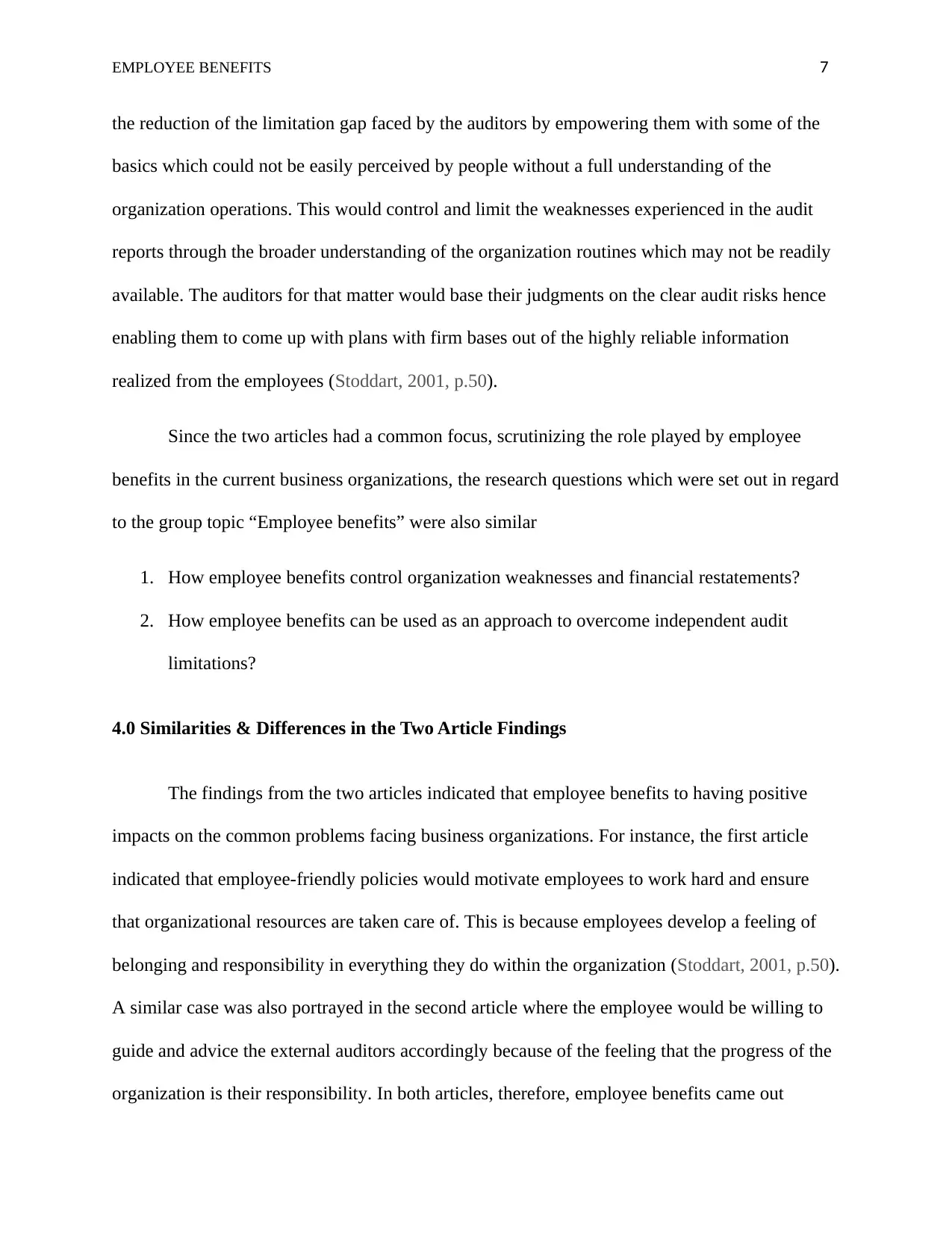
EMPLOYEE BENEFITS 7
the reduction of the limitation gap faced by the auditors by empowering them with some of the
basics which could not be easily perceived by people without a full understanding of the
organization operations. This would control and limit the weaknesses experienced in the audit
reports through the broader understanding of the organization routines which may not be readily
available. The auditors for that matter would base their judgments on the clear audit risks hence
enabling them to come up with plans with firm bases out of the highly reliable information
realized from the employees (Stoddart, 2001, p.50).
Since the two articles had a common focus, scrutinizing the role played by employee
benefits in the current business organizations, the research questions which were set out in regard
to the group topic “Employee benefits” were also similar
1. How employee benefits control organization weaknesses and financial restatements?
2. How employee benefits can be used as an approach to overcome independent audit
limitations?
4.0 Similarities & Differences in the Two Article Findings
The findings from the two articles indicated that employee benefits to having positive
impacts on the common problems facing business organizations. For instance, the first article
indicated that employee-friendly policies would motivate employees to work hard and ensure
that organizational resources are taken care of. This is because employees develop a feeling of
belonging and responsibility in everything they do within the organization (Stoddart, 2001, p.50).
A similar case was also portrayed in the second article where the employee would be willing to
guide and advice the external auditors accordingly because of the feeling that the progress of the
organization is their responsibility. In both articles, therefore, employee benefits came out
the reduction of the limitation gap faced by the auditors by empowering them with some of the
basics which could not be easily perceived by people without a full understanding of the
organization operations. This would control and limit the weaknesses experienced in the audit
reports through the broader understanding of the organization routines which may not be readily
available. The auditors for that matter would base their judgments on the clear audit risks hence
enabling them to come up with plans with firm bases out of the highly reliable information
realized from the employees (Stoddart, 2001, p.50).
Since the two articles had a common focus, scrutinizing the role played by employee
benefits in the current business organizations, the research questions which were set out in regard
to the group topic “Employee benefits” were also similar
1. How employee benefits control organization weaknesses and financial restatements?
2. How employee benefits can be used as an approach to overcome independent audit
limitations?
4.0 Similarities & Differences in the Two Article Findings
The findings from the two articles indicated that employee benefits to having positive
impacts on the common problems facing business organizations. For instance, the first article
indicated that employee-friendly policies would motivate employees to work hard and ensure
that organizational resources are taken care of. This is because employees develop a feeling of
belonging and responsibility in everything they do within the organization (Stoddart, 2001, p.50).
A similar case was also portrayed in the second article where the employee would be willing to
guide and advice the external auditors accordingly because of the feeling that the progress of the
organization is their responsibility. In both articles, therefore, employee benefits came out
Paraphrase This Document
Need a fresh take? Get an instant paraphrase of this document with our AI Paraphraser
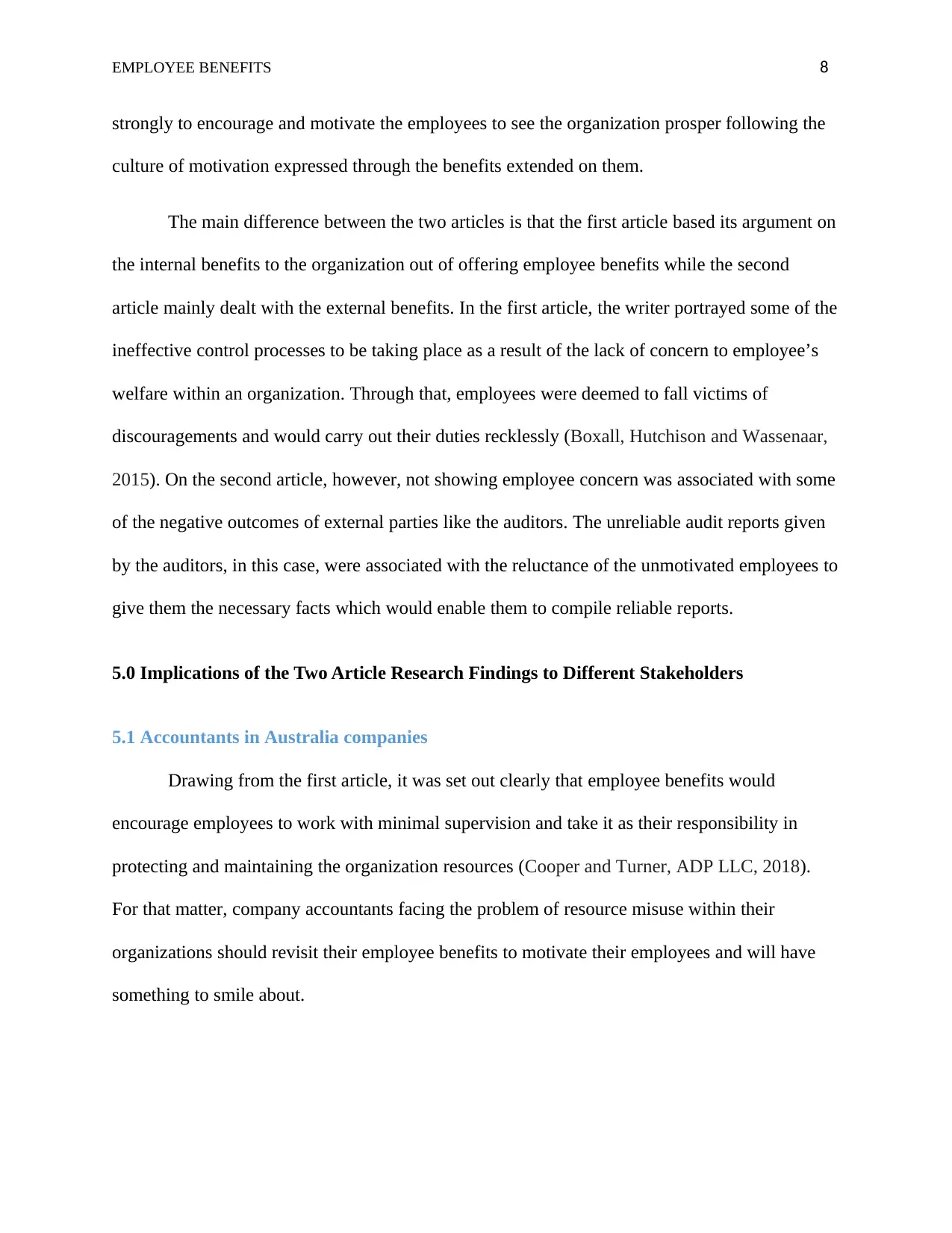
EMPLOYEE BENEFITS 8
strongly to encourage and motivate the employees to see the organization prosper following the
culture of motivation expressed through the benefits extended on them.
The main difference between the two articles is that the first article based its argument on
the internal benefits to the organization out of offering employee benefits while the second
article mainly dealt with the external benefits. In the first article, the writer portrayed some of the
ineffective control processes to be taking place as a result of the lack of concern to employee’s
welfare within an organization. Through that, employees were deemed to fall victims of
discouragements and would carry out their duties recklessly (Boxall, Hutchison and Wassenaar,
2015). On the second article, however, not showing employee concern was associated with some
of the negative outcomes of external parties like the auditors. The unreliable audit reports given
by the auditors, in this case, were associated with the reluctance of the unmotivated employees to
give them the necessary facts which would enable them to compile reliable reports.
5.0 Implications of the Two Article Research Findings to Different Stakeholders
5.1 Accountants in Australia companies
Drawing from the first article, it was set out clearly that employee benefits would
encourage employees to work with minimal supervision and take it as their responsibility in
protecting and maintaining the organization resources (Cooper and Turner, ADP LLC, 2018).
For that matter, company accountants facing the problem of resource misuse within their
organizations should revisit their employee benefits to motivate their employees and will have
something to smile about.
strongly to encourage and motivate the employees to see the organization prosper following the
culture of motivation expressed through the benefits extended on them.
The main difference between the two articles is that the first article based its argument on
the internal benefits to the organization out of offering employee benefits while the second
article mainly dealt with the external benefits. In the first article, the writer portrayed some of the
ineffective control processes to be taking place as a result of the lack of concern to employee’s
welfare within an organization. Through that, employees were deemed to fall victims of
discouragements and would carry out their duties recklessly (Boxall, Hutchison and Wassenaar,
2015). On the second article, however, not showing employee concern was associated with some
of the negative outcomes of external parties like the auditors. The unreliable audit reports given
by the auditors, in this case, were associated with the reluctance of the unmotivated employees to
give them the necessary facts which would enable them to compile reliable reports.
5.0 Implications of the Two Article Research Findings to Different Stakeholders
5.1 Accountants in Australia companies
Drawing from the first article, it was set out clearly that employee benefits would
encourage employees to work with minimal supervision and take it as their responsibility in
protecting and maintaining the organization resources (Cooper and Turner, ADP LLC, 2018).
For that matter, company accountants facing the problem of resource misuse within their
organizations should revisit their employee benefits to motivate their employees and will have
something to smile about.
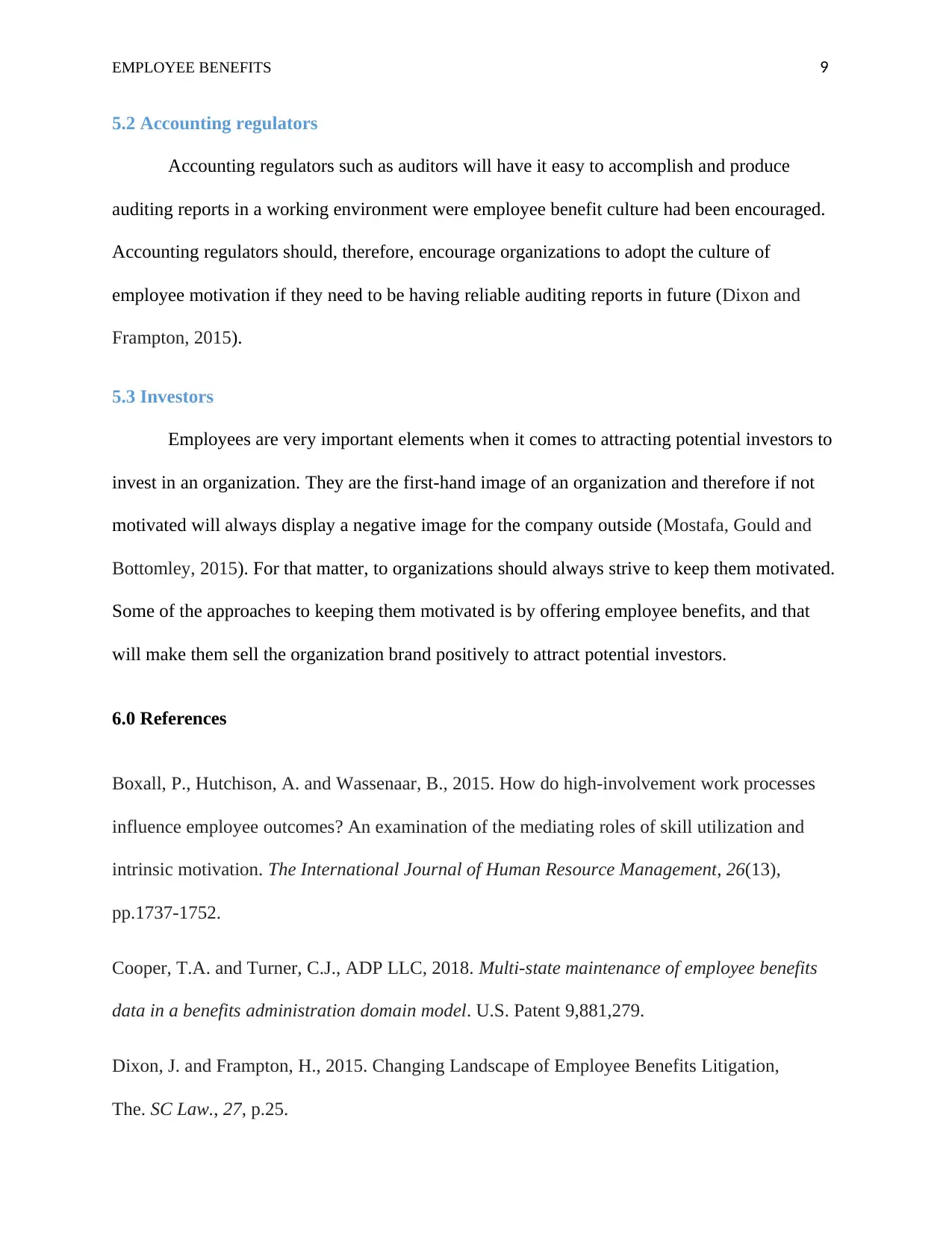
EMPLOYEE BENEFITS 9
5.2 Accounting regulators
Accounting regulators such as auditors will have it easy to accomplish and produce
auditing reports in a working environment were employee benefit culture had been encouraged.
Accounting regulators should, therefore, encourage organizations to adopt the culture of
employee motivation if they need to be having reliable auditing reports in future (Dixon and
Frampton, 2015).
5.3 Investors
Employees are very important elements when it comes to attracting potential investors to
invest in an organization. They are the first-hand image of an organization and therefore if not
motivated will always display a negative image for the company outside (Mostafa, Gould and
Bottomley, 2015). For that matter, to organizations should always strive to keep them motivated.
Some of the approaches to keeping them motivated is by offering employee benefits, and that
will make them sell the organization brand positively to attract potential investors.
6.0 References
Boxall, P., Hutchison, A. and Wassenaar, B., 2015. How do high-involvement work processes
influence employee outcomes? An examination of the mediating roles of skill utilization and
intrinsic motivation. The International Journal of Human Resource Management, 26(13),
pp.1737-1752.
Cooper, T.A. and Turner, C.J., ADP LLC, 2018. Multi-state maintenance of employee benefits
data in a benefits administration domain model. U.S. Patent 9,881,279.
Dixon, J. and Frampton, H., 2015. Changing Landscape of Employee Benefits Litigation,
The. SC Law., 27, p.25.
5.2 Accounting regulators
Accounting regulators such as auditors will have it easy to accomplish and produce
auditing reports in a working environment were employee benefit culture had been encouraged.
Accounting regulators should, therefore, encourage organizations to adopt the culture of
employee motivation if they need to be having reliable auditing reports in future (Dixon and
Frampton, 2015).
5.3 Investors
Employees are very important elements when it comes to attracting potential investors to
invest in an organization. They are the first-hand image of an organization and therefore if not
motivated will always display a negative image for the company outside (Mostafa, Gould and
Bottomley, 2015). For that matter, to organizations should always strive to keep them motivated.
Some of the approaches to keeping them motivated is by offering employee benefits, and that
will make them sell the organization brand positively to attract potential investors.
6.0 References
Boxall, P., Hutchison, A. and Wassenaar, B., 2015. How do high-involvement work processes
influence employee outcomes? An examination of the mediating roles of skill utilization and
intrinsic motivation. The International Journal of Human Resource Management, 26(13),
pp.1737-1752.
Cooper, T.A. and Turner, C.J., ADP LLC, 2018. Multi-state maintenance of employee benefits
data in a benefits administration domain model. U.S. Patent 9,881,279.
Dixon, J. and Frampton, H., 2015. Changing Landscape of Employee Benefits Litigation,
The. SC Law., 27, p.25.
⊘ This is a preview!⊘
Do you want full access?
Subscribe today to unlock all pages.

Trusted by 1+ million students worldwide
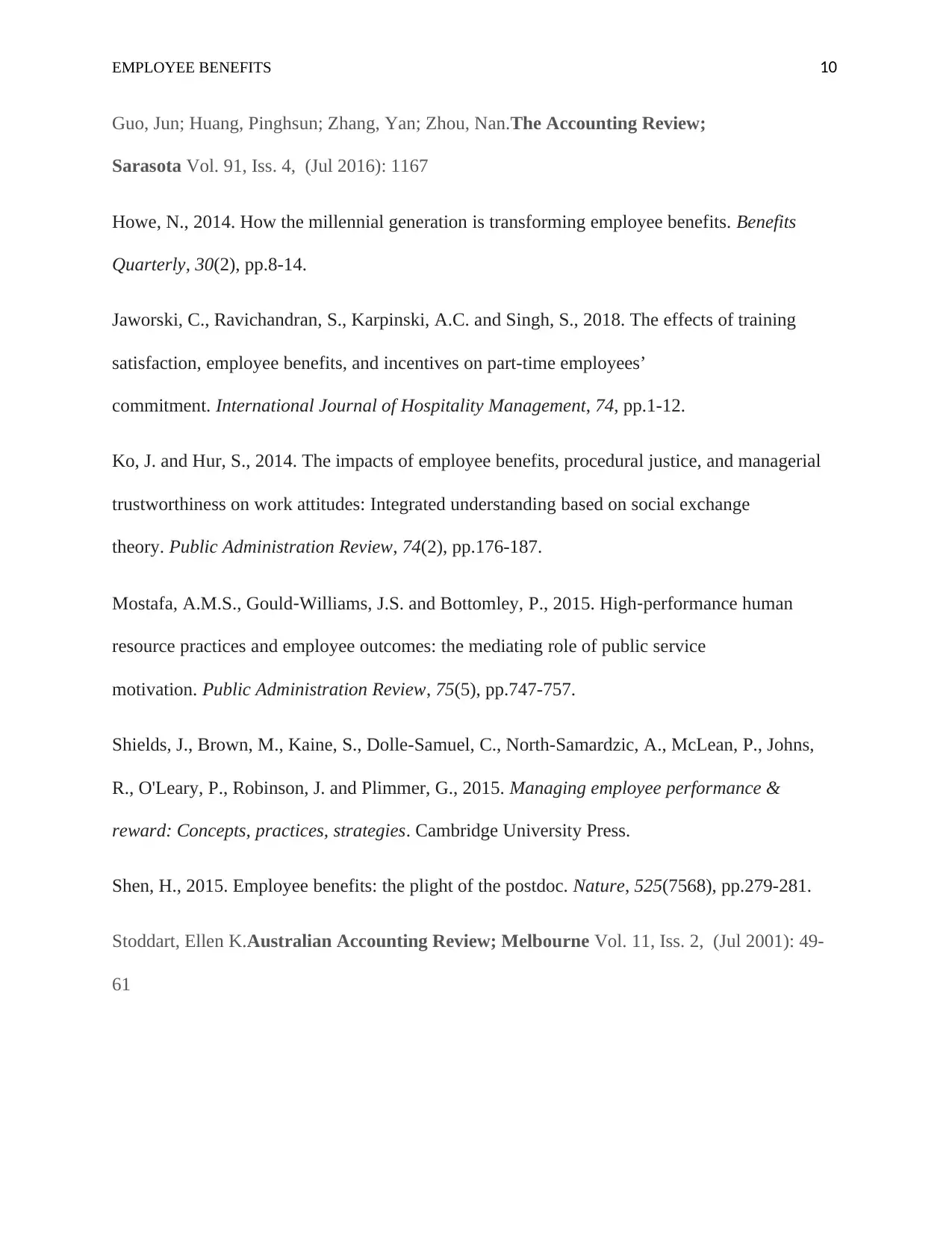
EMPLOYEE BENEFITS 10
Guo, Jun; Huang, Pinghsun; Zhang, Yan; Zhou, Nan.The Accounting Review;
Sarasota Vol. 91, Iss. 4, (Jul 2016): 1167
Howe, N., 2014. How the millennial generation is transforming employee benefits. Benefits
Quarterly, 30(2), pp.8-14.
Jaworski, C., Ravichandran, S., Karpinski, A.C. and Singh, S., 2018. The effects of training
satisfaction, employee benefits, and incentives on part-time employees’
commitment. International Journal of Hospitality Management, 74, pp.1-12.
Ko, J. and Hur, S., 2014. The impacts of employee benefits, procedural justice, and managerial
trustworthiness on work attitudes: Integrated understanding based on social exchange
theory. Public Administration Review, 74(2), pp.176-187.
Mostafa, A.M.S., Gould‐Williams, J.S. and Bottomley, P., 2015. High‐performance human
resource practices and employee outcomes: the mediating role of public service
motivation. Public Administration Review, 75(5), pp.747-757.
Shields, J., Brown, M., Kaine, S., Dolle-Samuel, C., North-Samardzic, A., McLean, P., Johns,
R., O'Leary, P., Robinson, J. and Plimmer, G., 2015. Managing employee performance &
reward: Concepts, practices, strategies. Cambridge University Press.
Shen, H., 2015. Employee benefits: the plight of the postdoc. Nature, 525(7568), pp.279-281.
Stoddart, Ellen K.Australian Accounting Review; Melbourne Vol. 11, Iss. 2, (Jul 2001): 49-
61
Guo, Jun; Huang, Pinghsun; Zhang, Yan; Zhou, Nan.The Accounting Review;
Sarasota Vol. 91, Iss. 4, (Jul 2016): 1167
Howe, N., 2014. How the millennial generation is transforming employee benefits. Benefits
Quarterly, 30(2), pp.8-14.
Jaworski, C., Ravichandran, S., Karpinski, A.C. and Singh, S., 2018. The effects of training
satisfaction, employee benefits, and incentives on part-time employees’
commitment. International Journal of Hospitality Management, 74, pp.1-12.
Ko, J. and Hur, S., 2014. The impacts of employee benefits, procedural justice, and managerial
trustworthiness on work attitudes: Integrated understanding based on social exchange
theory. Public Administration Review, 74(2), pp.176-187.
Mostafa, A.M.S., Gould‐Williams, J.S. and Bottomley, P., 2015. High‐performance human
resource practices and employee outcomes: the mediating role of public service
motivation. Public Administration Review, 75(5), pp.747-757.
Shields, J., Brown, M., Kaine, S., Dolle-Samuel, C., North-Samardzic, A., McLean, P., Johns,
R., O'Leary, P., Robinson, J. and Plimmer, G., 2015. Managing employee performance &
reward: Concepts, practices, strategies. Cambridge University Press.
Shen, H., 2015. Employee benefits: the plight of the postdoc. Nature, 525(7568), pp.279-281.
Stoddart, Ellen K.Australian Accounting Review; Melbourne Vol. 11, Iss. 2, (Jul 2001): 49-
61
Paraphrase This Document
Need a fresh take? Get an instant paraphrase of this document with our AI Paraphraser

EMPLOYEE BENEFITS 11
1 out of 11
Related Documents
Your All-in-One AI-Powered Toolkit for Academic Success.
+13062052269
info@desklib.com
Available 24*7 on WhatsApp / Email
![[object Object]](/_next/static/media/star-bottom.7253800d.svg)
Unlock your academic potential
Copyright © 2020–2025 A2Z Services. All Rights Reserved. Developed and managed by ZUCOL.




